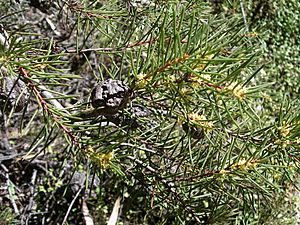Hakea pachyphylla facts for kids
Quick facts for kids Hakea pachyphylla |
|
|---|---|
 |
|
| Scientific classification | |
| Genus: |
Hakea
|
| Species: |
pachyphylla
|
 |
|
| Occurrence data from Australasian Virtual Herbarium | |
Hakea pachyphylla is a special kind of shrub that belongs to the Proteaceae plant family. It's found only in a specific area of Australia, high up in the Blue Mountains of New South Wales. People used to think it was just a different version of another plant called Hakea propinqua, but now we know it's its own unique species!
What it Looks Like
Hakea pachyphylla is a small to medium-sized shrub that grows from 0.3 to 2 meters (about 1 to 6.5 feet) tall. It has a single main stem and can grow in a compact or more spread-out shape.
Flowers and Leaves
This plant produces beautiful yellow flowers that grow in small groups of 1 to 7. These flower clusters appear in the leaf axils (where the leaf meets the stem) during spring, usually from August to October. The main stalk of the flowers is white and covered with tiny, matted hairs.
The small branches of the shrub have ribs and are also covered with soft, reddish hairs. These hairs often become smooth as the plant gets older. The leaves are stiff and look like needles. They are usually between 1 and 5.5 centimeters (about 0.4 to 2.2 inches) long and 1.1 to 1.8 millimeters (about 0.04 to 0.07 inches) wide. They might have a few flat hairs at first, but they quickly become smooth and end in a small point.
Fruit
After the flowers bloom, Hakea pachyphylla produces oval-shaped fruit. These fruits are about 2.9 to 3.5 centimeters (about 1.1 to 1.4 inches) long and 2.3 to 2.6 centimeters (about 0.9 to 1 inch) wide. They have small, blunt, wart-like bumps on them and a short, wide beak, sometimes with small "horns" that are hard to see.
How it Got its Name
The scientific name Hakea pachyphylla was first officially described in 1827. The second part of the name, pachyphylla, tells us something special about the plant. It comes from two ancient Greek words: pachys (παχύς), which means "thick," and phyllon (φύλλον), which means "leaf." So, pachyphylla means "thick-leaved," referring to the thick leaves of this plant.
Where it Grows
Hakea pachyphylla is quite rare because it only grows in a small area. You can find it in the Mount Victoria, Leura, and Newnes areas. These places are all located in the Blue Mountains of New South Wales. This plant likes to grow in swampy areas, open heathlands, or in places with a type of shrubland called mallee-heath. Sometimes, it can also be found growing on sandstone.

